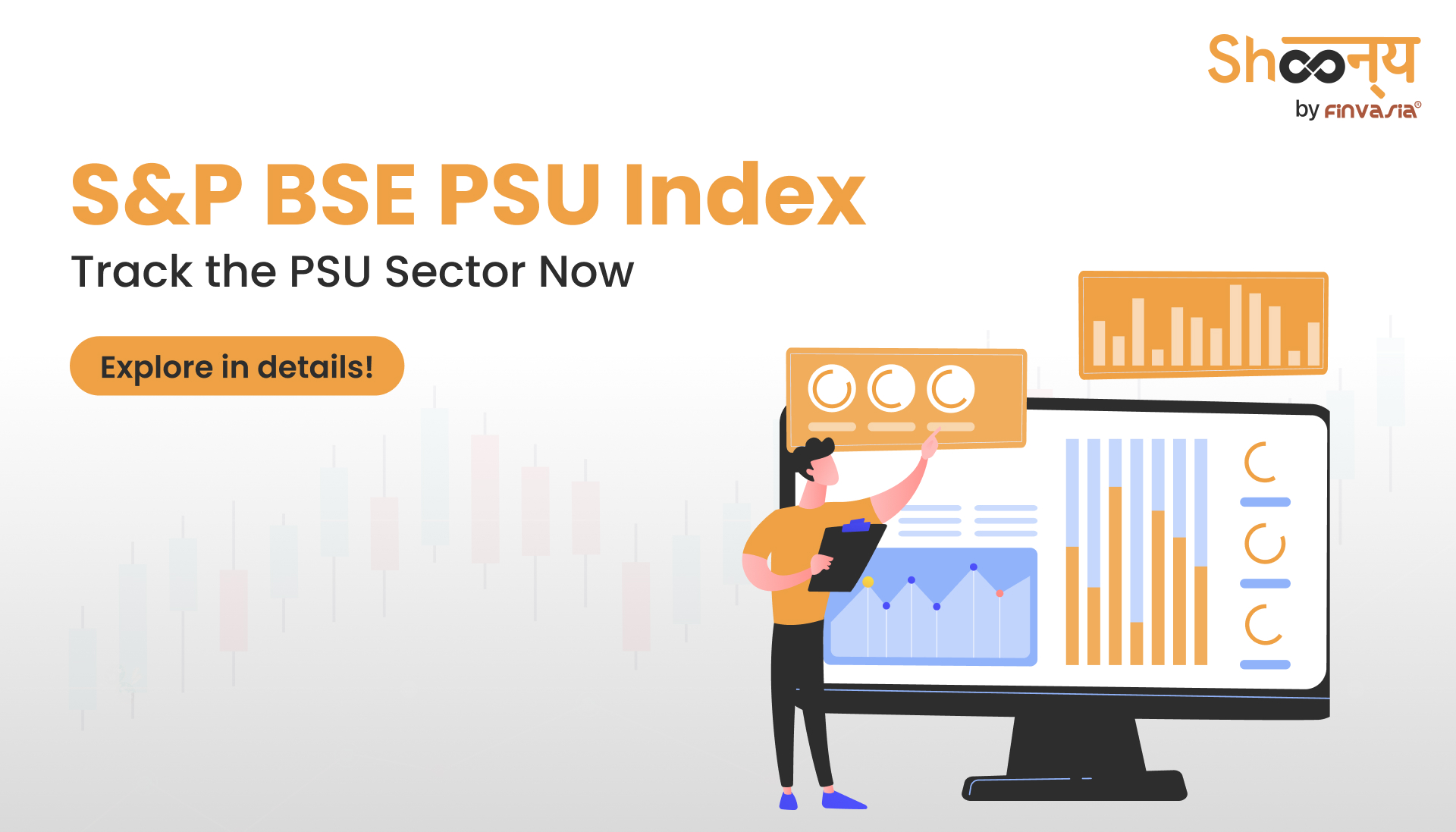Complete Guide to S&P BSE PSU Index: From Selection to Investment Process

Public Sector Undertakings (PSUs) have always been a haven for people who want to earn better returns than traditional investments such as FDs, and saving schemes, but are also cautious about taking higher risks. These companies are also favourites of most investors as they offer decent gains at lower risk. However, there are hundreds of such PSUs, and tracking them individually is a task. Thus, the S&P BSE PSU Index was launched to track the PSU companies.
This article will revolve around the S&P BSE PSU index, its constituents, selection criteria, investment process, returns, risks and more.
S&P BSE PSU Index – Overview & Constituents
The S&P BSE PSU index reflects the performance of the top 63 PSUs in India which are listed on the BSE. The index was launched on 4 June 2001. This is a well-diversified index as it includes PSUs from across the sectors.
The S&P BSE PSU index stocks list includes – (As of 4 February 2025)
| BANK OF BARODA | Garden Reach Shipbuilders & En | ITI LTD. | OIL INDIA LTD. |
| BANK OF INDIA | General Insurance Corporation | JAMMU & KASHMIR BANK LTD. | POWER FINANCE CORPORATION LTD. |
| BANK OF MAHARASHTRA | Gujarat Gas Limited | KIOCL Limited | POWER GRID CORPORATION OF INDI |
| BEML LTD. | GUJARAT MINERAL DEVELOPMENT CO | LIFE INSURANCE CORPORATION OF | PUNJAB & SIND BANK |
| Bharat Dynamics Limited | Hindustan Aeronautics Limited | MANGALORE REFINERY & PETROCHEM | PUNJAB NATIONAL BANK |
| BHARAT ELECTRONICS LTD. | HINDUSTAN COPPER LTD. | Mazagon Dock Shipbuilders Limi | Rail Vikas Nigam Limited |
| BHARAT HEAVY ELECTRICALS LTD. | HINDUSTAN PETROLEUM CORPORATION | Mishra Dhatu Nigam Limited | RASHTRIYA CHEMICALS & FERTILIZE |
| BHARAT PETROLEUM CORPORATION L | Housing &Urban Development Cor | MMTC LTD. | REC LIMITED |
| CANARA BANK | IFCI LTD. | NATIONAL ALUMINIUM CO. LTD. | RITES Limited |
| CENTRAL BANK OF INDIA | INDIAN BANK | NBCC (India) Limited | SJVN LTD |
| CHENNAI PETROLEUM CORPORATION | INDIAN OIL CORPORATION LTD. | NHPC LTD. | STATE BANK OF INDIA |
| COAL INDIA LTD. | INDIAN OVERSEAS BANK | NLC India Limited | STEEL AUTHORITY OF INDIA LTD. |
| Cochin Shipyard Limited | Indian Railway Catering and To | NMDC LTD. | The New India Assurance Compan |
| CONTAINER CORPORATION OF INDIA | Indian Railway Finance Corpora | NMDC Steel Limited | UCO BANK |
| ENGINEERS INDIA LTD. | Indian Renewable Energy Develo | NTPC LTD. | UNION BANK OF INDIA |
| GAIL (INDIA) LTD. | IRCON International Ltd | OIL AND NATURAL GAS CORPORATIONS | |
The top ten stocks by weightage –
| Stocks | Weightage (%) |
| State Bank of India | 16.59 |
| NTPC Ltd. | 8.4 |
| Power Grid Corporation of India | 7.35 |
| Bharat Electronics Ltd. | 5.58 |
| Oil And Natural Gas Corporation | 5.52 |
| Coal India Ltd. | 4.85 |
| Hindustan Aeronautics Ltd. | 3.75 |
| Power Finance Corporation Ltd. | 3.18 |
| REC Ltd. | 2.85 |
| Bharat Petroleum Corporation Ltd. | 2.77 |
Sectoral Weightage
| Sectors | Weightage (%) |
| Financial Services | 36.94 |
| Energy | 21.96 |
| Utilities | 17.77 |
| Industrials | 16.64 |
| Commodities | 3.98 |
| Consumer Discretionary | 1.34 |
| Services | 1.21 |
| Telecommunication | 0.17 |
Selection Criteria
The stock selection criteria for the equity index S&P BSE PSU index include –
- The security must be listed on BSE and a part of BSE 500 universe
- The security must be a public sector undertaking according to the BSE Sector Classification
- For the same it needs to have 51% or more of government ownership – it can be state government undertaking, central government, or governments jointly owning the enterprise
- The security must have been listed for at least a month before the review
Factors Affecting the S&P BSE PSU Index
The factors which affect the S&P BSE PSU index are –
- Demand and supply: The most important factor that affects the BSE PSU index is the demand-supply ratio. If the demand for the goods that the PSUs manufacture or the services they offer is high, the constituting companies will flare, which can take the index upward. When demand pressure declines, supply is in abundance, and prices drop, often hurting the financials of the companies and, in turn, dragging the index down.
- Government Intervention: As the PSUs are government undertakings, policies made by the governments affect these PSUs significantly.
- Economic Scenario: The economic scenario of the country determines the business of these PSUs. If the economic condition is poor, then it usually lowers the performance of the PSUs, and vice versa.
- Capital Expenditure: The capital expenditure by the government also plays a pivotal role in determining the movement of this PSU index. When capex increases, usually the PSUs perform better as more capital flows which leads to development, and prosperity and vice versa.
- Geopolitical Scenario: Finally, geopolitical issues such as the trade war between countries, also influence the business of these PSUs and thus affect the index valuation.
S&P BSE PSU Index Calculation Method
For the S&P BSE PSU index, the stocks are selected based on float-adjusted market cap weighted.
Index Value = Index Market Value/ Divisor
Here,
Index Market Value = Price of the security * number of securities * IWF (Float Factor)
Divisor = Market Value / Index Value
Performance and Returns
Here are the returns for different periods –
Price Returns & Total Returns
| Period | Price Return (%) | Total Return (%) |
| 1 Month | -2.53 | -2.34 |
| 3 Month | -7.55 | -6.90 |
| YTD | -2.53 | -2.34 |
| 1 Year | 6.33 | 9.22 |
| 3 Years | 26.81 | 31.43 |
| 5 Years | 22.87 | 28.01 |
| 10 Years | 8.41 | 12.31 |
Enjoy investing in the top stocks of the BSE 500 universe with the S&P BSE PSU index on Shoonya App!
Risk and Volatility
S&P BSE PSU Index encompasses multiple sectors which increases the diversification effect and reduces the risks to a great extent. However, there are certain risks which need to be considered and there is an analysis of its annualised risk and Annualised Risk-Adjusted Returns.
| Period | Annualised Risk (%) | Annualised Risk-Adjusted Returns (%) |
| Total Returns | ||
| 1 Year | – | – |
| 3 Years | 20.65 | 1.5 |
| 5 Years | 21.49 | 1.3 |
| 10 Years | 24.05 | 0.51 |
| Price Returns | ||
| 1 Year | – | – |
| 3 Years | 20.67 | 1.28 |
| 5 Years | 21.50 | 1.06 |
| 10 Years | 24.33 | 0.35 |
How to Invest in the S&P BSE PSU INDEX?
You can invest in the S&P BSE PSU Index using ETFs, or index funds, or you can trade them on the trading platform. You can also trade S&P BSE PSU Index futures, and options in the F&O section of Shoonya’s app. To do so, you have to add the index to your watchlist following these steps –
- Open the Shoonya app.
- Head to the “Watchlist” tab located at the bottom of your screen.
- In the search bar, type “NIFTY IN” or “SENSEX IN” and add it to the watch list, and then you will be able to see the indices. Choose the “BSE PSU Index”.
- Once you find your desired index, click on the add option given on the right side.
- Now you can see the index on the watchlist.
Conclusion
So, if you are interested in the public sector undertakings, or want to track them to understand the overall market dynamics, this BSE PSU Index can be your way to track the them without individually going through each PSU’s performance.
S&P BSE PSU Index | FAQs
The S&P BSE PSU index is rebalanced twice a year. The calculation frequency is real-time.
It uses the float-adjusted market cap weighted method.
The current PE of the S&P BSE PSU index is 11.67.
The S&P BSE PSU index was launched on 4 June 2001.
The base value used for index calculation is 1000.
The current P/B ratio of the index is 1.98.
The current dividend yield stands at 2.87%.
Source: BSEIndia
______________________________________________________________________________________
Disclaimer: Investments in the securities market are subject to market risks; read all the related documents carefully before investing.








